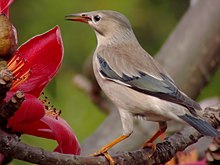Loading AI tools
Species of bird From Wikipedia, the free encyclopedia
The red-billed starling (Spodiopsar sericeus) is a species of starling in the family Sturnidae. It is found in south and southeastern China.
| Red-billed starling | |
|---|---|
 | |
| Scientific classification | |
| Domain: | Eukaryota |
| Kingdom: | Animalia |
| Phylum: | Chordata |
| Class: | Aves |
| Order: | Passeriformes |
| Family: | Sturnidae |
| Genus: | Spodiopsar |
| Species: | S. sericeus |
| Binomial name | |
| Spodiopsar sericeus (Gmelin, JF, 1789) | |
| Synonyms | |
|
Sturnus sericeus | |
The red-billed starling was formally described in 1789 by the German naturalist Johann Friedrich Gmelin in his revised and expanded edition of Carl Linnaeus's Systema Naturae. He placed it with the starlings in the genus Sturnus and coined the binomial name Sturnus sericeus.[2][3] The specific epithet sericeus is Medieval Latin meaning "silken".[4] Gmelin based his account on the "silk starling" from China that had been described and illustrated in 1776 by the English naturalist Peter Brown from a specimen owned by the collector Marmaduke Tunstall.[5]
The red-billed starling was formerly placed in the genus Sturnus. A molecular phylogenetic study published in 2008 found that the genus was polyphyletic.[6] In the reoganization to create monotypic genera, the red-billed starling and the white-cheeked starling were moved to the resurrected genus Spodiopsar that had been introduced in 1889 by Richard Bowdler Sharpe. The species is monotypic: no subspecies are recognised.[7]

Seamless Wikipedia browsing. On steroids.
Every time you click a link to Wikipedia, Wiktionary or Wikiquote in your browser's search results, it will show the modern Wikiwand interface.
Wikiwand extension is a five stars, simple, with minimum permission required to keep your browsing private, safe and transparent.